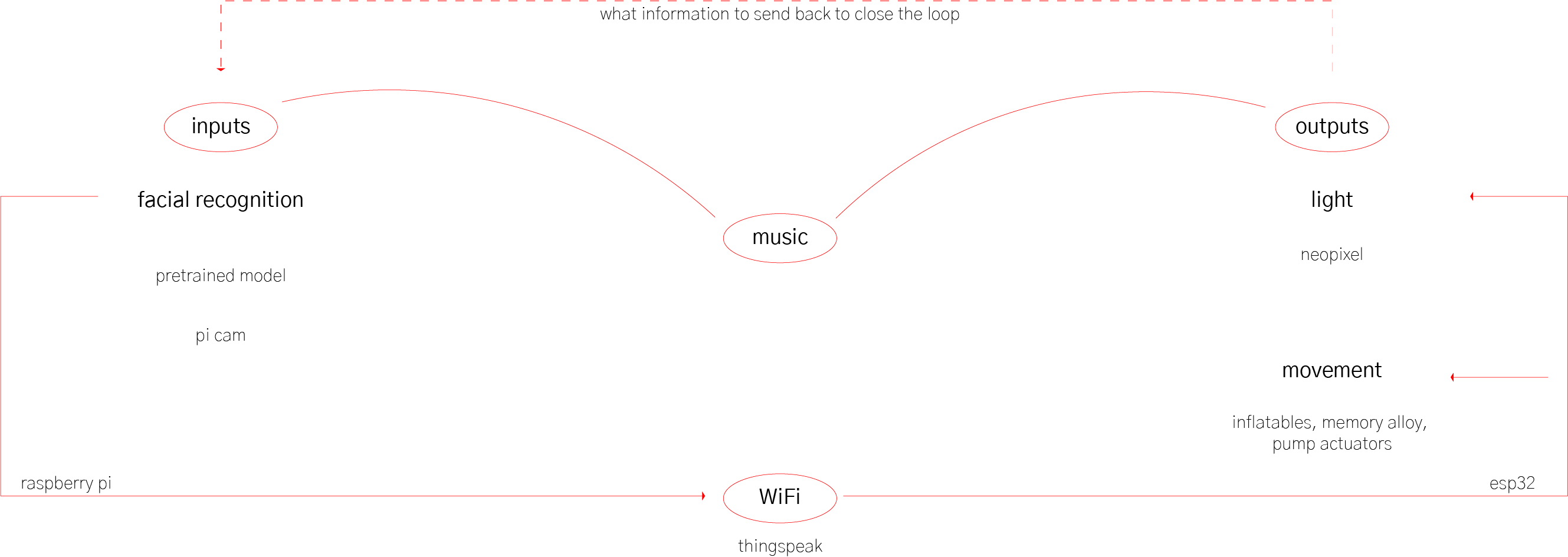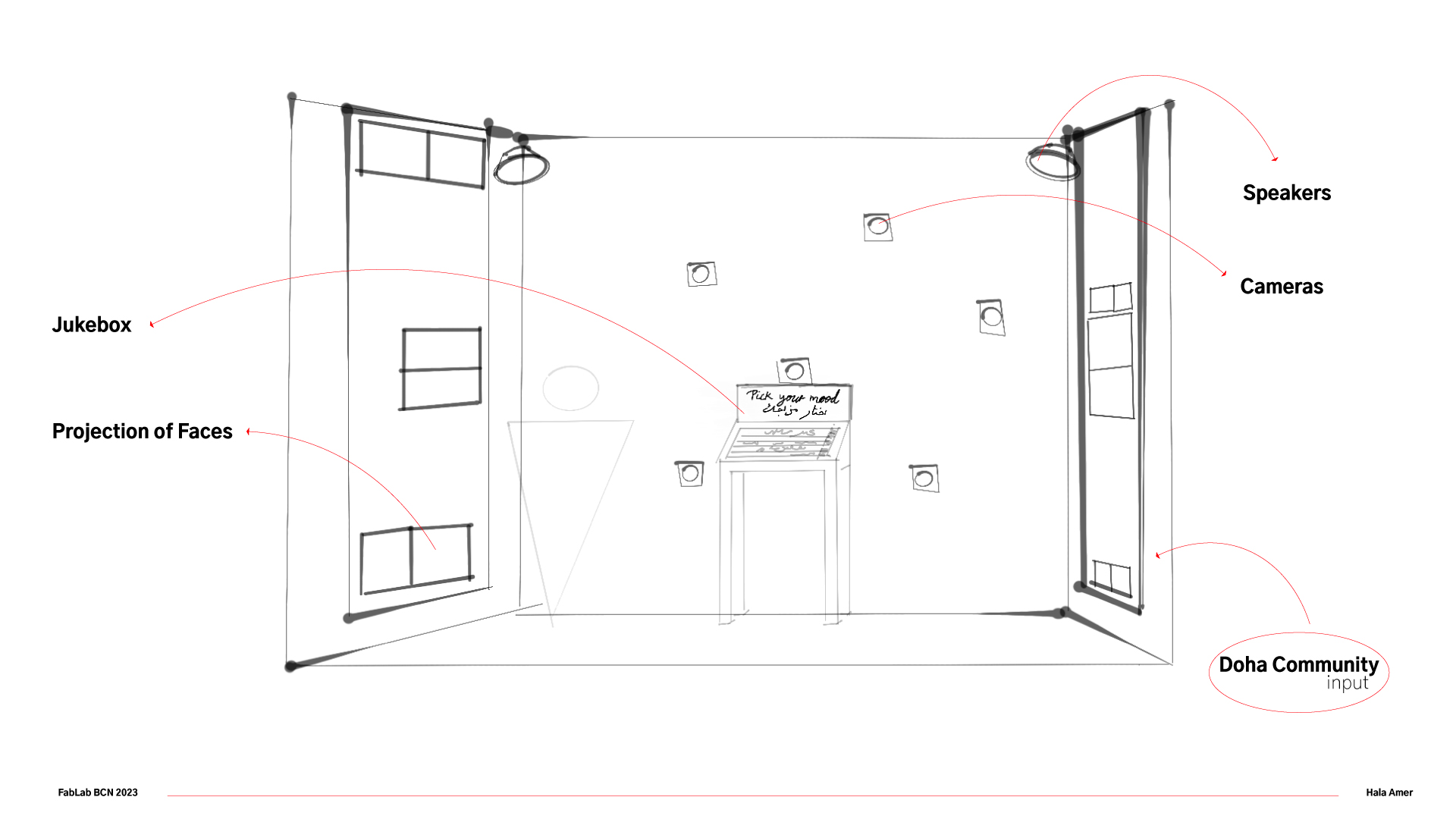Conceptualization & Ideation | Re-Humanizing Sensing¶
A portal between different communities to re-empathize with each other's humanity.
An interactive installation piece that translates data from one community to another through an (wearable) artefact for the purpose of celebrating the heritage, similarities, and differences of said communities in a human and proportional way.
It is called Re-Humanizing Sensing because we, collectively as humans, are at a point where we are constantly bombarded with information at a quick pace causing us to interact with it passively. We have grown to be de-sensitized to the information we see but partially notice.
This project aims to bring back the senses to the human who is designed to sense so naturally but has forgotten to do so.
Throughouht this project, the goal is to collect inputs from one community and outputs from the other and connect them through the artefacts. Ideally, the project will be presented through an exhibition both in Barcelona, Spain and Doha, Qatar. In this way, I am just the medium between the two for the transfer of the information.
I am looking at designers, material researchers, makers or artists from or based in Doha, Qatar and Barcelona, Spain. The inputs would be selected by those in Doha while the outputs are selected by those in Barcelona. Once these inputs and outputs are selected and connected to different emotions, I will act as a 'DJ' that will shuffle these inputs/outputs to project different emotions.
As emotions are a very intangible and abstract concept, I plan to work with a group within the community to translate them into tangible and concrete representations of themselves.
Some potential inputs could include sound, touch (or lack of), and light. While some potential outputs could include expansion, contraction, lighting, vibration, and colors. The artefact that will represent the outputs would utilize learnt skills from Soft Robotics, E-textiles, and Skin Electronics.
Projected Plan¶
The planning of the project can be roughly divided into four main topics: research, concept & design, fabrication, and dissemintation.
The main tasks falling underneath those 4 topics are:
| 1 - Research | Research on the abstract and how to turn it tangible. Finding the data that the project will focus on. |
| 2 - Concept & Design | Co-design & co-creation. Collecting selected data from my communities. |
| 3 - Fabrication | Experimenting with the tangible representation of data. |
| 4 - Fabrication | Prototyping electronics and wearables afor the artwork installation. |
| 5 - Dissemination | Finalizing the prorotypes and testing the emotions received by my output community. |
Throughout the development of this project there are some main activities that need to be done to make sure the project continues to be relevant.
Research Topics:
- Decolonizing Design
- Emotions: portraying and understanding them
Prototyping & Experimenting
- Starting early experiments with classmates:
- Creating different wearables weekly with outputs and a reflection and feedback sheet
- First experiments can be done with existing traditional music and some wearable device.
- Figuring out how to network the inputs and outputs across countries
- How the artefacts would look like
- What the artefacts would be made of
- What the workflow of the exhibition might be
Project Timeline
| Research | Researching in depth about facial expressions, their relation to emotions, and the differences between them globally | By January 20th |
| Fabrication | Testing out the facial recognition system with the Raspberry Pi using a large library with pre-trained models | By January 12th |
| Concept & Design | Writing, sketching, and prototyping the general artefact's aesthetics and functions | By January 31st |
| Dissemination | Writing about the artwork and sharing with interested spaces in Qatar for exhibiting | By January 31st |
| Fabrication | Finalizing the number of inputs and outputs, creating the connections, and testing them | By January 31st |
| Concept & Design | Defining all the cases that will interpret the inputs to the outputs | By February 9th |
| Fabrication | Creating the artefact and embedding the components in them | By February 16th |
| Dissemination | Designing the exhibtion and the user interactions | By March 1st |
Decolonizing Emotions & Expressions¶
Research provides that there is a fundamental difference of understanding emotional states and expressions between the East and the West. (research in references at the bottom of the page).
"These cultural differences are explained by the distinct characteristics of individualist and collectivist cultures. In Western culture, people try to influence others. For this purpose, high arousal emotions are ideal and effective. By contrast, in Eastern culture, adjusting and conforming to other people is considered desirable. To meet this goal, low arousal emotions work better than high arousal emotions." (Facial Recognition & Emotions, 4)
"Lu and Gilmour conducted a cross-cultural study on the conception of happiness; they found that the American conception of happiness emphasized on being upbeat, whereas the Chinese conception of happiness focused on being solemn and reserved." (Facial Recognition & Emotions, 4)

Above we can see different states of being that can refer to the concept of happiness depending on the cultural background.
Dr. Lisa Feldman Barrett talks about the bias of the association of certain expressions to emotions, she also mentions the difficulty and inaccuracy of aligning expressions to emotions. Which also includes the bias of Facial Emotion Recognition programs as the Facial Expression Analysis that is used in trainings for security, healthcare, AI and machine learning, etc is based off Western understanding of facial expressions. The studies conducted would always use posed photographs of normally Western models with exaggerated expressions.
Emotions and expressions are rarely directly connected and emotions are rarely related to one state of being. Emotional state is usually a cocktail of different states. Due to the limitation of language we attribute states that we are already familiar with to all that we experience.
For example, in Japanese, Age-otori, describes the feeling after getting a bad haircut. In Arabic, the word Inshallah is used commonly and directly translates to "God Willing", but it also conveys the feeling of being uncertain and hoping for the best. Another Arabic word, Tarab meaning a musically induced state of ecstasy or enchantment. There are many words in many different languages that exist to explain a specific cocktail of emotions that do not relate to the seven used in trainings, happy, sad, fearful, surprised, neutral, disgusted, and angry.
Imagined Functions¶

- Moving Inflatable
- Another Generosity
- Anicka Yi
- Inflatable
- mode:lina
- Vardiya (The Shift)
- Andela Andea
- Daan Roosegaarde
- Clementine Brandibas
- LilyPad Embroidery
Input/Output Flow Chart¶

initial flow chart - Jan 24

midterm flow chart Feb 24
Input¶

Output¶
To understand the performance of the object, its materiality, and how to produce it, I began by writing the Object's personality and character.

Exhibition Sketches¶


initial sketch


midterm sketch
Constant Alternative Ideation:
The inflatable object as the performer triggered by the subtle reactions of the input community to the music playing. Through the performance to the song, reactions are triggered in the output community. The output community reactions can be sent back to the input community.
Expressions & Emotions Translator: coming up with 'synonyms' and 'translations' of emotions and expressions due to the expressions and inputs of both communities. In this case, the project would be more screen based with facial recognition capture and translator output on both sides.
References¶
Here will be a list of references, research papers, books, articles, and projects that I have and will continue to accumulate throughout the project.
Topic: Decolonizing Design
- Decolonizing Design: A Cultural Justice Guidebook by Elizabeth (Dori) Tunstall.
- Decolonizing Reader: An in-progress collaborative project since 2018 by Ramon Tejada
- What Does it Mean To Decolonize Design? by Anoushka Khandwala
- Decolonizing Design
- Decolonizing Design Lecture Series ft. Elizabeth Tunstall
- The Politics of Design
- To See in Reverse: Decoding and Decolonizing Design Language and Thinking
Topic: Human & Sensing
- See Yourself X: Human Futures Expanded by Madeline Schwartzman
- PAL: a wearable on-device deep learning platform for personalized, context-aware, and closed loop real-time support by Mina Khan
- Emotional Clothing by Iga Weglinska
- Wisteria: Emotive Intelligent Architecture as an Embodiment of Human Emotion and Cognition by Morphogenesis Lab
- Poly by Gerard Visuals
- Displacements by Citlali Hernandez Sanchez
- The World Pulse by Domestic Data Streamers
- About Time
- Relationship between sound & light
Topic: Facial Recognition & Emotions